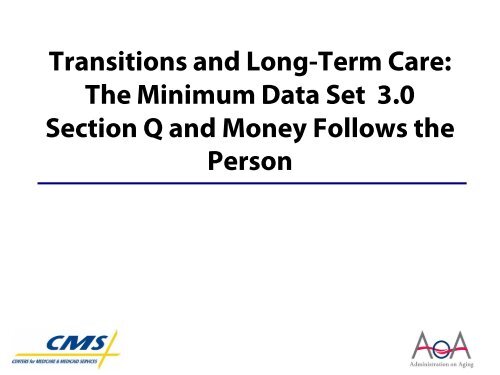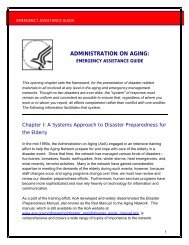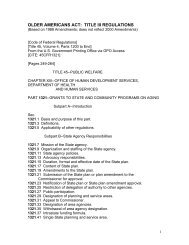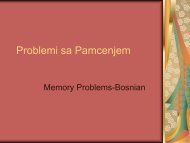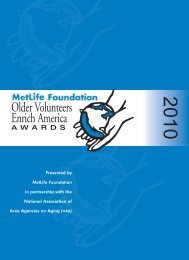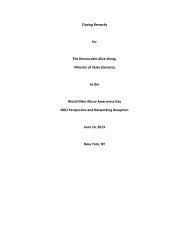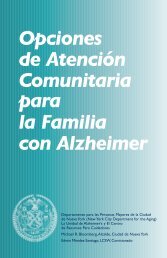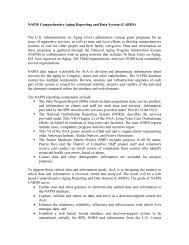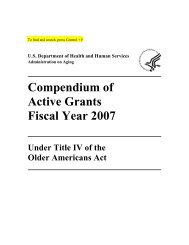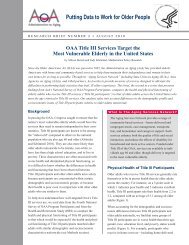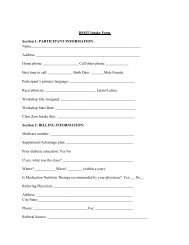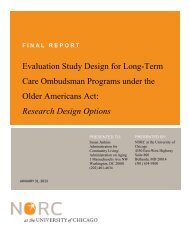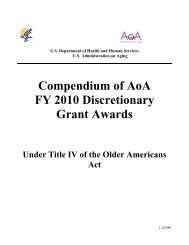Transitions and Long-Term Care: The Minimum Data Set 3.0 Section ...
Transitions and Long-Term Care: The Minimum Data Set 3.0 Section ...
Transitions and Long-Term Care: The Minimum Data Set 3.0 Section ...
Create successful ePaper yourself
Turn your PDF publications into a flip-book with our unique Google optimized e-Paper software.
5<strong>Minimum</strong> <strong>Data</strong> <strong>Set</strong> (MDS) <strong>3.0</strong>• Nursing Facility Resident Assess Instrument– Used for all nursing facility residents– Primarily used for rate setting & quality assurance• Version <strong>3.0</strong> implemented on October 1, 2010• CMS used the opportunity to improve thefunctionality of <strong>Section</strong> Q –Participation in Assessment<strong>and</strong> Goal <strong>Set</strong>ting– More person-centered -- interview resident/family– Action Steps – Connection to Local Contact Agency (LCA)
6Need for Change Identified• CMS conducted an open dialogue as part of the <strong>Section</strong> Qimplementation process– Open Forum teleconferences– Monthly State Medicaid Agency teleconferences– Discussion sessions at conferences– Posting Questions & Answers on CMS website– Posting Pilot Test Results– Posting Local Contact Agencies & State coordinator Points of Contact• Ongoing input from Improving <strong>Transitions</strong> Work Group (States<strong>and</strong> other Stakeholders)
7Results of the Dialogue• Many program operation issues were resolved• Suggestions for improving the functioning of <strong>Section</strong> Q weremade– Skip patterns may preclude resident choice– Feasibility of discharge question may exclude potential c<strong>and</strong>idates fortransitioning– Need to better accommodate residents with cognitive impairments,dementia, mental illness– Some residents need to explore more options– Some residents/families were upset by being asked about returning tothe community
8Changes• Feasibility of discharge item was dropped• Individuals can opt-out of being asked if theywant to speak to someone about returning tothe community• Some clarifying language changes were made
9Intent of Changes• Adopt a more person-centered approach• Place resident/family at center of decisionmaking• Give individual residents a voice <strong>and</strong> a choicewhile being sensitive to those who may beupset by the assessment process• Be more targeted about who gets queried
10Results of the Process• Suggested changes were incorporated intonew draft <strong>Section</strong> Q <strong>and</strong> discussed withImproving <strong>Transitions</strong> Work Group• Proposed language changes were pilot testedin six states (9 facilities) in February 2011• Results are being incorporated in MDSrevisions to be implemented in April 2012
11Current VersionChanges to <strong>Section</strong> Q:Side-by-Side ComparisonsQ0100A. Resident participated in assessment0. No1. Yes SameQ0100B. Family or significant other participated inassessment0. No1. Yes2. No family or significant otherQ0100C. Guardian or legally authorized representativeparticipated in assessment0. No1. Yes2. No guardian or legally authorized representativeApril 2012 VersionSameSameIn User’s Manual: “Resident has no family orsignificant other”SameIn User’s Manual: “Resident has no guardian orlegally authorized representative”
12Changes to <strong>Section</strong> Q (continued)Current Version (on admission)Q0300. Resident’s Overall ExpectationA. Select one for resident’s overall goal established duringassessment process1. Expects to be discharged to the community2. Expects to remain in this facility3. Expects to be discharged to another facility/institution9. Unknown or uncertainApril 2012 VersionSameQ0300B. Indicate information source for Q0300A1. Resident2. If not resident, then family or significant other3. If not resident, family or significant other, then guardianor legally authorized representative9. None of the aboveSameSameSame9. Unknown or uncertain
13Changes to <strong>Section</strong> Q (continued)Q0400 Discharge PlanCurrent VersionA. Is there an active discharge plan in place for theresident to return to the community?0. No1. Yes -> Skip to Q0600, ReferralB. What determination was made by the resident<strong>and</strong> the care planning team that discharge tocommunity is feasible?0. Determination not made1. Discharge to community is feasible – Skip toQ06002. Discharge to community is not feasible – Skip tonext active sectionApril 2012 VersionA. Is active discharge planning alreadyoccurring for the resident to return to thecommunity?SameSameItem eliminated
14Changes to <strong>Section</strong> Q (continued)Q0490. Resident’s Preference to Avoid Being Asked QuestionQ0500B (complete only when A0310 = 02, 06, 99)Current VersionDoes not existApril 2012 VersionA. Is there documentation in the resident’s clinical recordstating only to ask this question on comprehensiveassessments?0. No1. Yes, Unless is comprehensive assessment, ( in User’sManual) -> Skip to Q0600, Referral8. Information not available
15Changes to <strong>Section</strong> Q (continued)Q0500. Return to CommunityCurrent VersionB. Ask the resident, (or family orsignificant other if resident is unable torespond): “Do you want to talk tosomeone about the possibility ofreturning to the community?”0. No1. Yes2. Unknown or uncertainApril 2012 VersionB. Ask the resident, (or family orsignificant other if resident is unable tounderst<strong>and</strong> or respond): “Do you want totalk to someone about the possibility ofreturning to the community?”SameSame9. Unknown or uncertain
16Changes to <strong>Section</strong> Q (continued)Q0550. Resident’s Preference to Avoid Being Asked Question Q0500B againCurrent VersionApril 2012 VersionA. Does not exist A. Does the resident, (or family or significant other or guardian, ifresident is unable to respond) want to be asked about returning to thecommunity on all assessments? (rather than only on comprehensiveassessments)0. No – then document in resident’s chart (clinical record) <strong>and</strong> only askagain on the next comprehensive assessment.1. Yes8. Information not availableB. Does not exist B. Indicate information source for Q0550A1. Resident2. If not resident, then family or significant other3. If not resident, family or significant other, then guardian or legallyauthorized representative8. No information source available
17Changes to <strong>Section</strong> Q (continued)Q0600. ReferralCurrent VersionHas a referral been made to the LocalContact Agency?0. No - determination has been made bythe resident <strong>and</strong> the care planning teamthat contact not required.1. No – referral not made2. YesApril 2012 VersionHas a referral been made to the LocalContact Agency? (Document reasons inresident’s chart)0. No - referral not needed1. No – referral is or may be needed (Formore information See <strong>Section</strong> Q <strong>Care</strong>Area Assessment- #20)2. Yes – referral made
18Expected Impacts• Based on pilot test results; big caveats• By eliminating the Determination of Feasibilityof Discharge item, many more residents wereasked the question, “Do you want to talk withsomeone about the possibility of leaving thisfacility <strong>and</strong> returning to live <strong>and</strong> receiveservices in the community?”• And many more said Yes
19Expected Impacts (continued)• By giving residents/families an opt-out provision (forthose who cannot or do not want to move out), onsubsequent quarterly assessments about talking tosomeone about returning to the community, theylikely will be less upset– Should reduce the number of residents for whom the question is notappropriate– Works better than the feasibility-of-discharge question in targetingwho should be asked the return to community question• More clarity about referrals– But key is communication at the local level
20Challenges• Ongoing outreach <strong>and</strong> education to nursing homes(NH)• NH making effective referrals, knowing who to contact• NH <strong>and</strong> LCA making connections to work together forresident in person-centered approach• Implementation of an effective referral <strong>and</strong> transitionplanningprocess at local level, i.e., LCA, Area Agencieson Aging (AAA), Aging <strong>and</strong> Disability Resource Centers(ADRC), MFP, <strong>and</strong> other stakeholders
21New Opportunities• AoA, CMS, <strong>and</strong> Veterans Affairs (VA) workingtogether to provide information <strong>and</strong> resourcesfor each Agency <strong>and</strong> their Stakeholders• State VA programs <strong>and</strong> funding streams vary• Goal is to work for Veterans in a person-centeredapproach for appropriate referrals <strong>and</strong> to meettransition planning needs• Veterans in NHs <strong>and</strong> State Veterans Homesdepending on length of service <strong>and</strong> level of VAbenefits can be eligible for wrap-aroundMedicaid <strong>and</strong> other services
22For more information:For more information:• Send questions to:www.MDSforMedicaid@cms.hhs.gov
Money Follows the PersonRebalancing DemonstrationJohn SorensenMFP Project Officer <strong>and</strong> MDS <strong>Section</strong> QDevelopment <strong>and</strong> Implementation TeamDivision of Community Systems TransformationDisabled & Elderly Health Programs GroupCenter for Medicaid, CHIP <strong>and</strong> Survey &Certification
24Current CMS RebalancingOptions• Person-Centered Hospital Discharge Planning – Active through September2012 – assists States with the development <strong>and</strong> implementation ofenhanced hospital discharge models <strong>and</strong> with increasing capacity of singleentry points (including ADRCs). Participating States: AK, CA, HI, ID, KS, MD,MO, NC, OR, <strong>and</strong> SC.• Affordable <strong>Care</strong> Act (ACA): <strong>Section</strong> 2703: Health Homes for Individualswith Chronic Conditions– States are able to offer health home services for individuals with multiplechronic conditions or serious mental illness effective January 1, 2011– Coordinated, person-centered care– Primary, acute, behavioral, long term care, social services = whole person– Enhanced Federal Medical Assistance Percentage, or FMAP (90%) is availablefor the health home services (first 8 quarters)
25Current CMS RebalancingOptions• ACA: Community First Choice (CFC) - 1915(k) State PlanOption– Goal - To provide “person-centered” home <strong>and</strong>community-based attendant services <strong>and</strong> supports as anoptional service under the State Plan– Effective October 1, 2011– Financial Incentive - 6% increased FMAP
26<strong>Section</strong> 2403: Money Followsthe Person• Now extends through 2019-transitionsindividuals from institutions to communitybased care <strong>and</strong> adds resources to balancelong-term care (LTC)• Enhanced Federal match for communityservices for first year following transition fromfacility• 43 States <strong>and</strong> the District of Columbia nowparticipating in the demonstration
MFP States27
28Goals of MFP• Transition individuals to the community FromInstitutional <strong>Long</strong>-<strong>Term</strong> <strong>Care</strong> <strong>Set</strong>tings• Rebalance the long-term care system by:– Eliminating barriers to home <strong>and</strong> communitybasedservices (HCBS) <strong>and</strong> transitioning frominstitutional settings– Increasing availability of <strong>and</strong> access to HCBS• Assure HCBS quality procedures
29MFP Quality ManagementSystem• In addition to waiver quality requirements,States must ensure the following:– Risk assessment <strong>and</strong> mitigation process– A 24 hour emergency back–up system– Incident report management system
30Categories of Services• Qualified HCBS: Services that beneficiariestypically would receive• Demonstration Services: Optional servicesthat States can choose to cover• Supplemental Services: One-time or limiteddurationservices
31MFP <strong>Transitions</strong> by PopulationDistribution of Total MFP<strong>Transitions</strong> As of September 201119.9%1.8% 7.5%42.0%28.8%ElderlyUnder 65 with PhysicalDisabilitiesPeople with IntellectualDisabilitiesOtherSource: Mathematica analysis of quarterly MFP Program Participation <strong>Data</strong> files submittedthrough December 9, 2011.Note: This graph depicts the distribution of the total number of MFP transitions that haveoccurred since program start through the end of September 2011. Viriginia is excluded from thisanalysis because of missing data. In addition, transitions in Arkansas, California, the District ofColumbia, Maryl<strong>and</strong>, Michigan, New York, <strong>and</strong> Wisconsin are underreported because of lags instate data submissions.As of December 31, 2011 more than 16,000 transitionshave occurred under MFP since 2008
32Medicaid ACA: <strong>Section</strong> 2403:Money Follows the Person• ADRC/MFP Supplemental funding opportunity: in 2010, (25 States)up to $400,000 for MFP <strong>and</strong> ADRC was provided for MFP Granteesto work together to exp<strong>and</strong> ADRCs, build processes & partnership& utilize MDS <strong>3.0</strong> <strong>Section</strong> Q• States eligible for the 2012 ADRC Supplemental FundingOpportunity: CO, FL, GA, HI, ID, IL, ME, MA, MS, MN,NV, NJ, NM,OH, RI, SC, TN, VT, WV• MFP States will submit with budget in early 2012, approved by Aprilof 2012• CMS is planning a MFP solicitation for the remaining 7 States tobecome participating MFP Grantees, hope to release sometime inFebruary <strong>and</strong> award in late Spring, early Summer
MDS <strong>3.0</strong> <strong>Section</strong> Q, MFP <strong>and</strong> theAging NetworkBecky KurtzDirector, Office of the <strong>Long</strong>-<strong>Term</strong> <strong>Care</strong>Ombudsman ProgramAdministration on Aging
34Among the objectives of the Older Americans Act (OAA):Freedom, independence, <strong>and</strong> the free exercise ofindividual initiative in planning <strong>and</strong> managing theirown lives, full participation in the planning <strong>and</strong>operation of community based services <strong>and</strong> programsprovided for their benefit, <strong>and</strong> protection againstabuse, neglect, <strong>and</strong> exploitation.<strong>Section</strong> 101(10) of the Older Americans Act.
35<strong>The</strong> Aging Network• Established by the Older Americans Act, todaythe Aging Network consists of:– 56 State agencies on aging,– 629 area agencies on aging,– nearly 20,000 service providers, <strong>and</strong>– 244 Tribal organizations, <strong>and</strong> 2 Native Hawaiianorganizations representing 400 Tribes
36Roles of Aging Network in SupportingNursing Home <strong>Transitions</strong> Work• Providing consumers with assistance withtransition from nursing home to HCBS• Increased dem<strong>and</strong> for long-term services <strong>and</strong>supports (LTSS)• State <strong>and</strong> local-level policy development <strong>and</strong>implementation• Ombudsman resident advocacy• Follow up after transition
37Providing Information about Home<strong>and</strong> Community-Based Services• Information <strong>and</strong> Referral: Providinginformation to access LTSS -- an importantrole of the Aging Network for many years• LCAs: Part of MDS <strong>3.0</strong> <strong>Section</strong> Q– States have met need in a variety of ways:• ADRC serve as sole LCA (12 states)• ADRC designated as at least one of several LCAs (39states)
38Role of ADRCs• A single, coordinated system of information <strong>and</strong> access for allpersons seeking long-term support to minimize confusion,enhance individual choice, <strong>and</strong> support informed decisionmaking– Most include an Area Agency on Aging (71%)– 383 local ADRC programs in 51 states <strong>and</strong> territories,covering 60% of population
39Role of ADRCs (cont’d)• CMS <strong>and</strong> AoA envision ADRCs to:– Catalyze broader systems change– Promote participant-direction– Build stronger partnerships across fragmented LTSS system– Intervene during care transitions from hospitals <strong>and</strong> other acute care settings– Assist with institutional transitions– Implement new initiatives (e.g., Veteran-Directed Home <strong>and</strong> Community BasedServices, MDS <strong>3.0</strong> <strong>Section</strong> Q)• Synergy between development of ADRCs <strong>and</strong> need forLCAs as part of MDS <strong>3.0</strong> <strong>Section</strong> Q implementation• CMS/AoA announced grant opportunities in 2010 <strong>and</strong>2011 using MFP funds to support ADRC <strong>and</strong> otherAging Network involvement in <strong>Section</strong> Qimplementation
40Increased Dem<strong>and</strong>s for LTSS• As people move out of nursing homes <strong>and</strong> into othersettings, they require more of the services providedthrough the Aging Network:– OAA Home <strong>and</strong> Community Based Services (HCBS) – e.g.,nutrition, social services, caregiver services (allstates/territories)– One or more Medicaid HCBS waiver programs areprovided through Aging Network (32 states*)– State funded HCBS through Aging Network (24 states*)– In some states, the Aging Network is providing thetransition services for MFP (e.g., OH, GA)*Source: NASUAD, “State of the States Survey 2011”
41State <strong>and</strong> Local Level PolicyDevelopment <strong>and</strong> Implementation• State units on aging, State long-term care ombudsmen<strong>and</strong> others in Aging Network have been engaging withstate Medicaid agencies <strong>and</strong> others in design <strong>and</strong>implementation of:– MFP– <strong>Section</strong> Q initiatives.• Examples:– Developing MFP protocols, evaluation processes– Designing LCA processes (e.g., “NC MDS <strong>3.0</strong> <strong>Section</strong> QReferral Response Toolkit” developed by NC CommunityResource Connections for Aging <strong>and</strong> Disabilities)– Educating consumers <strong>and</strong> nursing home staff re: <strong>Section</strong> Q(e.g., Nebraska <strong>Long</strong>-<strong>Term</strong> <strong>Care</strong> Ombudsman Program)
42Ombudsman Resident AdvocacyNovember 2010 Letter from Cindy Mann (CMS) <strong>and</strong> Kathy Greenlee (AoA):“<strong>The</strong> Office of the State LTC Ombudsman [LTCO] is astakeholder that should be included in the development<strong>and</strong> implementation of all MFP programs. <strong>The</strong>y are acritical resource to provide information to the [StateMedicaid Agency] on how the <strong>Section</strong> Q referral <strong>and</strong>follow-up process is functioning <strong>and</strong> to h<strong>and</strong>le consumercomplaints should they arise. Any State that currently hasan MFP Demonstration Grant program can requestsupplemental administrative funds to work directly withthe State LTC Ombudsman.”http://www.aoa.gov/AoARoot/AoA_Programs/Elder_Rights/Ombudsman/docs/AoA_CMS_<strong>Section</strong>_Q_memo.pdf
43Ombudsman Resident Advocacy(continued)• Helps keep process focused on the consumer’s priorities• Examples of LTCO activities re: nursing home transitions:– conducting outreach to residents;– educating residents/families about the <strong>Section</strong> Q process <strong>and</strong>HCBS options;– making referrals to LCAs;– supporting residents through the transition planning process;<strong>and</strong>– resolving consumer complaints related to the <strong>Section</strong> Q process.• 41% increase in LTCO complaints from nursing homeresidents related to “request for less restrictive placement”in FY 10 (compared to FY 08)
44Follow-up After Transition• Examples of Aging Network roles related to follow-up with residentafter transition:– Case management/provision of HCBS– MFP quality of life surveys– Access to adult protective services (APS)*, elder abuse preventionservices, <strong>and</strong> legal services when the needs arise• Individuals need protection from abuse, neglect, exploitation in all settings– Ombudsman follow-up/complaint resolution• Available in assisted living/board <strong>and</strong> care– NOTE: MFP limited to congregate settings of 4 beds or less• 12 states exp<strong>and</strong> LTCO complaint resolution services to individuals receivingin-home services (state law)• Some states have exp<strong>and</strong>ed LTCO service to in-home MFP consumers (e.g.,GA, DE)*APS is housed within the Aging Network in 27 states
45Integrating Functions Across CorePrograms
46<strong>Section</strong> Q Challenges:1 st Year of Implementation• Insufficient community resources to accommodatetransition• Lack of timeliness of the process• Challenges in discussing community options with residentswith dementia or diminished capacity• Family/guardian disagreements with resident preferences• Emotional stress <strong>and</strong> anxiety residents may experience ifthey believe they can transfer to the community but theyhave not yet been given community options.Source: National Ombudsman Resource Center 2010-2011 questionnaires to LTCOmbudsmen http://www.ltcombudsman.org
47<strong>Section</strong> Q Successes• Residents who wish to are returning to the community• Improved collaboration <strong>and</strong> communication betweenthe nursing home staff <strong>and</strong> other agencies• Nursing homes have improved their communicationwith residents especially during care plans <strong>and</strong>explaining community options• Residents have a better underst<strong>and</strong>ing of their rights<strong>and</strong> community optionsSource: National Ombudsman Resource Center 2010-2011 questionnaires to LTCOmbudsmen http://www.ltcombudsman.org
48Conclusion• Through initiatives such as MDS <strong>3.0</strong> <strong>Section</strong> Q<strong>and</strong> MFP, CMS, AoA, nursing homes, <strong>and</strong> theAging Network are indeed helping increasingnumbers of our nation’s nursing home residentsexperience:- Freedom, independence, <strong>and</strong> the free exercise ofindividual initiative in planning <strong>and</strong> managing theirown lives, <strong>and</strong>- Full participation in the planning <strong>and</strong> operation ofcommunity based services <strong>and</strong> programs provided fortheir benefit.
NC’s “No Frills” Presentation aboutMFP, ADRCs, LCAs <strong>and</strong> GettingPeople HomeTrish Farnham, NC MFP Project Director, Divisionof Medical Assistance (DMA)Lorrie Roth, LCA Coordinator, Division of Aging<strong>and</strong> Adult Services (DAAS)With Diane Upshaw, MFP AdministrativeCoordinator, DMA
50Brief Overview of NC MFP• Began supporting people to transition in 2009.• Supports three primary groups: individuals withintellectual disabilities (I/DD); individuals withphysical disabilities <strong>and</strong> older adults.• Historically, NC’s state-level transition infrastructurehas been more coordinated for individuals with I/DDthan for individuals within physical disability <strong>and</strong>aging communities, which were more local.• ADRC network <strong>and</strong> MDS <strong>3.0</strong> key pieces instrengthening statewide network that also plays tothe strengths of local efforts.
51Brief Overview of ADRC <strong>Set</strong>-Up inNorth Carolina• ADRC= NC Community Resources Connections (CRCs)• No wrong door• Options Counseling• Intent to cover all 100 counties by end of 2012– NC is big state, with both rural <strong>and</strong> urban areas.– Many local areas are already well-networked.• Typical “anchoring” partners: AAAs, IndependentLiving, Dept. of Social Services• Goal: statewide IT network.• <strong>Long</strong>-term goal: Figuring out “transition teams”
52How NC’s LCA Structure Emerged• NC’s Medicaid Agency (DMA) had not yet identified LCAentity.• Joint conversations between CRC State Director, MFP, MDSSteering Committee• LCA function is logical extension of CRCs’ optionscounseling role.– Fleshed out role <strong>and</strong> developed protocols in conjunction with localCRC representatives• Used MFP administrative funding <strong>and</strong> Opportunity C grantfunding to support LCA function <strong>and</strong> provide outreach– “MDS Roadshows”
53LCA Current Structure• DMA/MFP funds/DAAS manages– Including Opportunity C funds• Each CRC identifies LCA– May be one or more entities• In areas where no CRC, LCA funds flowthrough AAAs– Intended to be “seed money” for new CRC/LCAs.
54LCA Referral & ResponseFlowchart of LCA Activities
55Lessons Learned:What Works• What works about structure– Local knowledge – existing relationships– Opportunity to get word out about MFP– Funding– Collaboration between state agencies in gettingthe word out.oMFP Roadshows/Division of Health Service Regulation
56Lessons Learned: Challenges• Everything was new!– MDS <strong>3.0</strong>, LCA, MFP, CRCs. Often introducing multiple functions/ initiatives, not justLCA.• CRCs not statewide yet.– Had to create Plan B for uncovered areas– But this has also served as great “seed” for future CRC development.• Initial confusion about MDS referral process.– Initially, high volume of calls to Call Center. Created “volume anxiety” among LCAsinitially.• Weak correlation between LCA visit <strong>and</strong> MFP applications.– In 2011, less than 5% of MFP’s total application volume was a result of an LCA visit.• Communication Challenges– Multiple state players: sometimes we experienced “Who’s on first?” challenges– Lack of integrated statewide database– But lack of automation created stronger “human” systems regarding informationcollection <strong>and</strong> feedback loops.
57Emerging Opportunities• Partnership has created much stronger ties aroundtransition work between sister agencies.• LCA function/resources now serve as “seedmoney” for CRC expansion.• Exploring how to best integrate LCA into transitionplanning process.– Sometimes same agency is serving role of LCA <strong>and</strong>transition coordination.– We worked so hard to clearly define roles <strong>and</strong> prevent“function creep” that we inadvertently limited people’spotential engagement.
58Why It Matters:A Quick Story
59Resources: MDS <strong>3.0</strong> <strong>Section</strong> Q• http://www.cms.gov/NursingHomeQualityInits/25_NHQIMDS30.asp#TopOfPage (CMS resources on MDS <strong>3.0</strong>)• http://www.cms.gov/NursingHomeQualityInits/45_NHQIMDS30TrainingMaterials.asp#TopOfPage (CMS training on MDS<strong>3.0</strong>)• http://www.ltcombudsman.org/issues/MDS-<strong>3.0</strong> (National<strong>Long</strong>-<strong>Term</strong> <strong>Care</strong> Ombudsman Resource Center resources onMDS <strong>3.0</strong>)
60Resources: MFP• http://www.medicaid.gov/Medicaid-CHIP-Program-Information/By-Topics/<strong>Long</strong>-<strong>Term</strong>-Services-<strong>and</strong>-Support/Balancing/Money-Follows-the-Person.html (MFPweb site)• http://www.cms.gov/SMDL/SMD/list.asp#TopOfPage (StateMedicaid Director letters)• http://mfp-tac.com/ (MFP technical Assistance web site)
61Resources: Affordable <strong>Care</strong> Act• http://www.aoa.gov/Aging_Statistics/Health_care_reform.aspx (AoA’s Health Reform web page – where webinarrecordings, transcripts <strong>and</strong> slides are stored)• http://www.healthcare.gov (Department of Health <strong>and</strong>Human Services’ health care reform web site)• http://www.thomas.gov/ (Affordable <strong>Care</strong> Act text <strong>and</strong>related information)
62Next Training• Million Hearts– Tuesday, February 28, 2:00-3:30 pm Eastern– Watch your email in early February forregistration information
63Questions/Comments/Stories/Suggestions for Future Webinar Topics?Send them to:Affordable<strong>Care</strong>Act@aoa.hhs.gov


